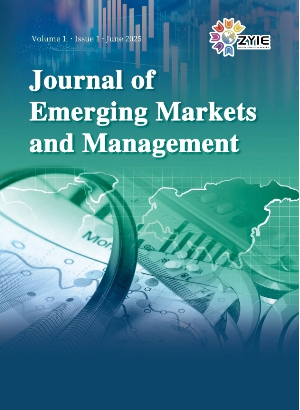Digital Transformation and SME Growth in Emerging Markets
DOI:
https://doi.org/10.63385/jemm.v1i1.35Keywords:
Digital Transformation, Emerging Markets, SMEs, Urban and Regional Planning, Spatial DevelopmentAbstract
Small and medium-sized enterprises (SMEs) are pivotal to local economic resilience, employment generation, and innovation in emerging markets. As urbanisation accelerates and digital economies expand, digital transformation emerges not only as a technological imperative but as a developmental and spatial strategy. This paper explores the evolving relationship between digitalisation and SME growth in developing contexts, drawing from the perspective of urban and regional planning. While digital tools offer SMEs new pathways to participate in broader markets and streamline operations, their uptake is often constrained by infrastructure deficits, regulatory uncertainty, and spatial disparities in digital access. Through a critical review of scholarly literature, policy documents, and institutional reports, this study identifies key barriers and strategic responses associated with SME digitalisation. Particular attention is paid to how digital infrastructure, governance environments, and urban–rural linkages influence the efficacy of digital transformation efforts. Strategies such as fintech integration, digital hubs, and public–private partnerships are evaluated for their relevance in spatially diverse regions. The findings highlight the need for place-based, multi-scalar policy responses that align digital transformation initiatives with inclusive urban development and spatial equity. This study contributes to a more integrated understanding of digital development, one that merges technology with territorial planning and offers insights for policymakers, planners, and SME practitioners navigating the digital economy in emerging markets.
References
[1] World Bank, 2022. Small and Medium Eterprise (SMEs) Finance. Available from: https://www.worldbank.org/en/topic/smefinance (cited 30 May 2025).
[2] OECD, 2019. Enhancing the contributions of SMEs in a global and digitalised economy. C/MIN(2017)8, 29 May 2017. Available from: https://one.oecd.org/document/C/MIN(2017)8/en/pdf (cited 30 May 2025).
[3] Beck, T., Demirgüç-Kunt, A., 2006. Small and medium-size enterprises: Access to finance as a growth constraint. Journal of Banking & Finance. 30(11), 2931–2943. DOI: https://doi.org/10.1016/j.jbankfin.2006.05.009
[4] World Bank, 2021. Small and medium enterprises (SMEs) finance. Available from: https://www.worldbank.org/en/topic/smefinance (cited 30 May 2025).
[5] Singh, A., Hess, T., 2017. How Chief Digital Officers promote the digital transformation of their companies. MIS Quarterly Executive. 16(1), 1–17.
[6] ITU, 2022. Measuring digital development: Facts and figures 2022. Available from: https://www.itu.int/hub/publication/d-ind-ict_mdd-2022/ (cited 30 May 2025).
[7] Kraus, S., Palmer, C., Kailer, N., et al., 2019. Digital entrepreneurship: A research agenda on new business models for the twenty-first century. International Journal of Entrepreneurial Behavior & Research. 25(2), 353–375. DOI: https://doi.org/10.1108/IJEBR-06-2018-0425
[8] World Economic Forum, 2020. The future of financial infrastructure: An ambitious look at how blockchain can reshape financial services. World Economic Forum. 49, 368–376.
[9] Barney, J.B., 1991. Firm resources and sustained competitive advantage. Journal of Management. 17(1), 99–120. DOI: https://doi.org/10.1177/014920639101700108
[10] Tornatzky, L.G., Fleischer, M., 1990. The Processes of Technological Innovation. Lexington Books: Lexington, MA, USA.
[11] GSMA Intelligence, 2025. Mobile Technologies and Digital Transformation to Boost Global GDP by $11 Trillion by 2030. Available from: https://www.linkedin.com/posts/gsma_mobile-technologies-and-digital-transformation-activity-7298310998388625410-4iXE (cited 30 May 2025).
[12] World Bank, 2020. World Development Report 2020: Trading for Development in the Age of Global Value Chains. World Bank: Washington, DC, USA. DOI: https://doi.org/10.1596/978-1-4648-1457-0
[13] United Nations Conference on Trade and Development (UNCTAD), 2021. Digital economy report 2021: cross-border data flows and development: for whom the data flow. United Nations Publications: New York, USA.
[14] International Telecommunication Union, 2021. Measuring Digital Development: Facts and Figures 2021. Geneva: ITU Statistics. Available from: https://www.itu.int/en/ITU-D/Statistics/Documents/facts/FactsFigures2021.pdf (cited 30 May 2025).
[15] ITU, 2022. Digital Trends in Asia and the Pacific 2022. Available from: https://www.itu.int (cited 30 May 2025).
[16] OECD, 2020. The Digital transformation of SMEs: OECD SME and Entrepreneurship Papers. No. 14. Available from: https://doi.org/10.1787/bdb9256a-en (cited 30 May 2025).
[17] Teece, D., 2007. Explicating dynamic capabilities: the nature and microfoundations of (sustainable) enterprise performance. Strategic Management Journal. 28(13), 1319–1350.
[18] Mutula, S., Van Brakel, P., 2006. An Evaluation of e-readiness assessment tools with respect to information access: Towards an integrated information rich tool. International Journal of Information Management, 26 (3), 212–223.
[19] Fisera, B., Horvath, R., Melecky, M., 2019. Basel III Implementation and SME Financing: Evidence for Emerging Markets and Developing Economies. Policy Research Working Paper No. 96069. Available from: https://documents1.worldbank.org/curated/en/441951575300867782/txt/Basel-III-Implementation-and-SME-Financing-Evidence-for-Emerging-Markets-and-Developing-Economies.txt (cited 30 May 2025).
[20] Klapper, L. F., 2005. The Role of Factoring for Financing Small and Medium Enterprises. Journal of Banking & Finance. 30(11), 3111–3130. DOI: https://doi.org/10.1016/j.jbankfin.2006.05.001
[21] Jack, W., Suri, T., 2018. Payment instruments, finance and development: Evidence from mobile money. Journal of Development Economics, 133, 162–186.. DOI: https://doi.org/10.1016/j.jdeveco.2018.01.005
[22] Vial, G., 2019. Understanding digital transformation: A review and a research agenda. The Journal of Strategic Information Systems. 28(2), 118–144. DOI: https://doi.org/10.1016/j.jsis.2019.01.003
Downloads
License
Copyright (c) 2025 Kiara Rampaul

This work is licensed under a Creative Commons Attribution 4.0 International License.



 PDF
PDF
